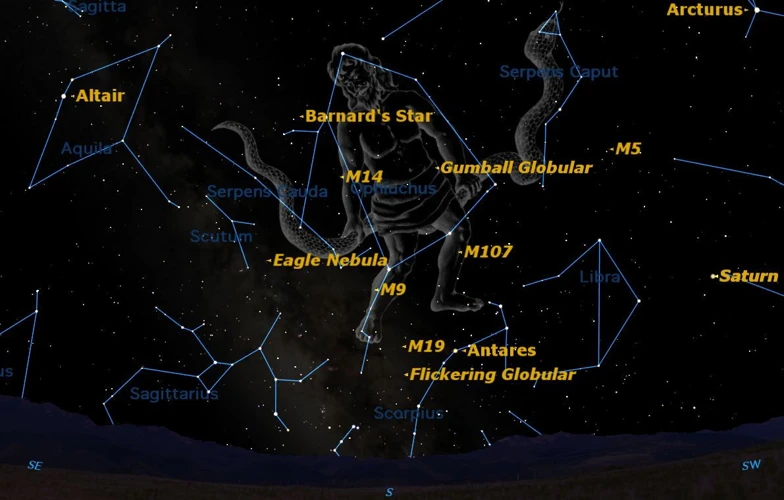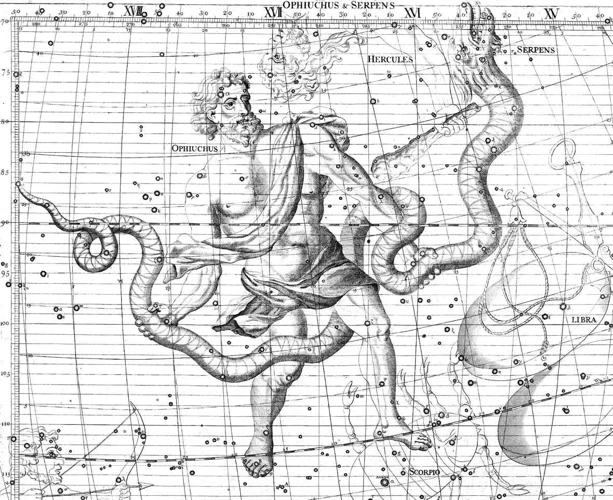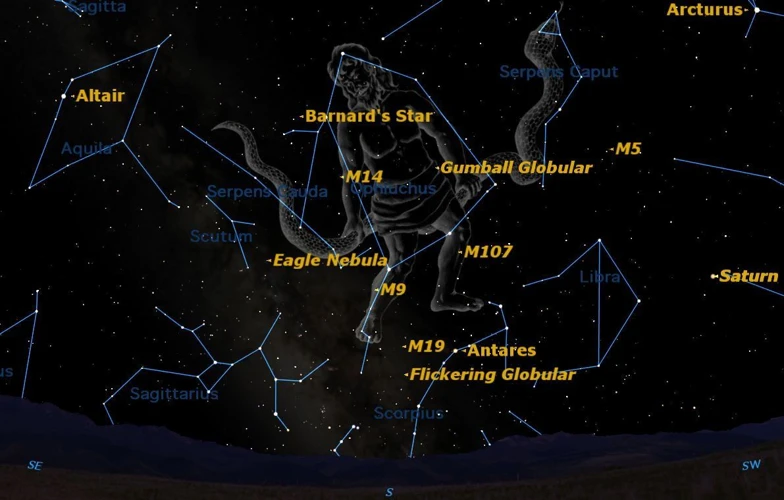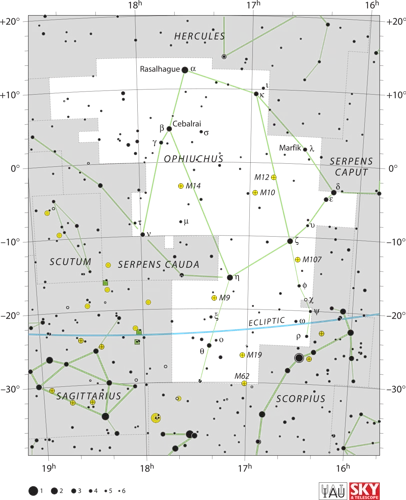Uncovering the Stories behind Modern Constellations: Have you ever looked up at the night sky and wondered about the stories behind the constellations? These celestial patterns have fascinated humans for centuries, serving as navigation aids, mythological characters, and scientific tools. While many are familiar with the ancient constellations, the modern ones also have intriguing tales to tell. From the Great Bear to the Telescope, this article explores the history, creation, and significance of both well-known and lesser-known modern constellations. Embark on a journey through the cosmos and discover the captivating narratives hidden within the stars.
Contents
- The History of Constellations
- Creation of Modern Constellations
- The Stories behind Major Modern Constellations
- Lesser-known Modern Constellations
- Conclusion
-
Frequently Asked Questions
- 1. How were ancient constellations created?
- 2. Who is credited with creating the first catalogue of constellations?
- 3. How are modern constellations named and designed?
- 4. What role do mythology and culture play in the creation of modern constellations?
- 5. What scientific contributions have modern constellations made?
- 6. What is the story behind the constellation Ursa Major?
- 7. What is the significance of Orion in mythology and astronomy?
- 8. Who was Cassiopeia in mythology, and how is she represented in the night sky?
- 9. What does Draco, the Dragon, symbolize in mythology and astronomy?
- 10. What are some lesser-known modern constellations and their stories?
- References
-
Frequently Asked Questions
- 1. How were the first constellations named and designed?
- 2. What is the role of culture and mythology in the creation of modern constellations?
- 3. What scientific contributions have influenced the development of modern constellations?
- 4. What is the story behind Ursa Major (The Great Bear)?
- 5. What is the significance of Orion (The Hunter) in mythology?
- 6. Who was Cassiopeia (The Queen) in mythology?
- 7. What is the story behind Draco (The Dragon) constellation?
- 8. What is the symbolism behind the Telescopium (The Telescope) constellation?
- 9. What does Caelum (The Chisel) constellation represent?
- 10. What is the significance of Circinus (The Compasses) in astronomy?
- References
- Read More
The History of Constellations

The History of Constellations: The study of constellations dates back to ancient civilizations, where early humans gazed up at the night sky and recognized patterns in the stars. One of the oldest known constellations is Ursa Major, also known as the Great Bear, which can be traced back to ancient Greek and Roman cultures. These early civilizations used constellations as a way to navigate and track the changing seasons.
The Greeks made significant contributions to the development of constellations, with the famous astronomer Ptolemy creating a list of 48 constellations in the 2nd century AD. These constellations formed the basis of Western astronomy for centuries to come. During the European Renaissance, explorers began to sail the seas and relied heavily on celestial navigation, turning to constellations for guidance.
In the 17th and 18th centuries, astronomers began to map out constellations in a more structured way, dividing the sky into regions and assigning names to specific star patterns. This was done to aid astronomers in locating and studying various celestial objects. This systematic approach led to the formation of modern constellations.
Today, constellations continue to play an essential role in astronomy and cultural storytelling. They provide a way to connect with the past and understand the vastness of our universe. From the ancient origins to the modern interpretations, exploring the history of constellations is a fascinating journey that allows us to appreciate the beauty and wonder of the night sky.
Creation of Modern Constellations

The creation of modern constellations involved a combination of naming, designing, and cultural influences. Astronomers and organizations have played a significant role in shaping these celestial patterns. The International Astronomical Union (IAU) has been instrumental in officially recognizing and standardizing the modern constellations. They have divided the sky into 88 official constellations, each with its own unique characteristics and stories. To design the constellations, astronomers identified clusters of stars and connected them with imaginary lines to form recognizable shapes like animals, objects, and mythological figures. Cultural and mythological influences have also played a crucial role in the creation of modern constellations. For example, Orion, the Hunter, is a prominent modern constellation derived from Greek mythology. These new constellations allow us to connect with our past while navigating the night sky with a blend of science and storytelling.
1. Naming and Designing
Naming and Designing: When it comes to naming and designing modern constellations, several factors come into play. Astronomers and experts in the field have the responsibility of assigning names and identifying distinct patterns in the night sky. The International Astronomical Union (IAU) plays a crucial role in this process, as they are the governing body responsible for officially recognizing and approving new constellations and their names.
The naming of modern constellations often draws inspiration from various sources, including Greek and Roman mythology, historical figures, and significant scientific discoveries. For example, the constellation Orion, known as “The Hunter,” is named after the mythical Greek hunter and features prominent stars that form the shape of a hunter’s belt. Similarly, Cassiopeia, “The Queen,” is named after a queen from Greek mythology known for her beauty and vanity.
Designing modern constellations involves identifying and mapping out groups of stars that form recognizable patterns or shapes. These patterns are often visualized by connecting the stars with imaginary lines, creating a distinct figure. The IAU provides guidelines to ensure that constellations are universally recognized and distinguished from one another, taking into consideration visibility from different latitudes and the cultural significance of specific constellations in different regions.
The naming and designing process of modern constellations is a delicate balance between scientific accuracy, cultural symbolism, and preserving the historical and mythological connections that have shaped constellations for centuries. With every new discovery and understanding of the universe, astronomers continue to expand our knowledge and create new constellations that reflect the evolving nature of astronomy.
2. Influence of Culture and Mythology
Culture and mythology have played a significant role in shaping modern constellations. Throughout history, different cultures around the world have assigned their own unique stories and interpretations to the patterns of stars. These stories often reflect beliefs, legends, and mythological characters that hold cultural significance.
For example, the constellation Orion, known as “The Hunter,” is featured in various mythologies. In Greek mythology, Orion was a handsome hunter who was ultimately transformed into a constellation by the gods. The story of Orion is also found in other cultures, such as the Indigenous Australian, where it is associated with the Dreamtime, a time of creation and storytelling.
Similarly, Cassiopeia, “The Queen,” originates from Greek mythology. Cassiopeia was the mother of Andromeda and boasted about her daughter’s beauty, angering the gods. As a result, she was placed in the sky as a punishment, forever condemned to sit on her throne.
Draco, “The Dragon,” is another constellation with mythical origins. In Greek mythology, Draco represents the dragon that guarded the Golden Fleece. It is said to be slayed by the hero Jason and his crew during the quest of the Argonauts.
These stories and cultural influences have not only shaped the names and designs of modern constellations but have also provided a sense of connection and meaning to the celestial realm. Exploring the impact of culture and mythology on constellations allows us to delve into the rich tapestry of human history and imagination, as we seek to unravel the mysteries of the stars above.
3. Scientific Contributions
3. Scientific Contributions:
Constellations not only serve as storytelling devices and navigational tools, but they also hold significant scientific importance. Throughout history, astronomers have made various scientific contributions through their observations of constellations. Here are a few examples:
A. Classification of Stars: By studying the patterns formed by stars within constellations, astronomers have been able to classify and categorize different types of stars based on their properties, such as their temperature, size, and brightness. This classification system, known as stellar classification, has provided valuable insights into the life cycle and behavior of stars.
B. Identification of Celestial Objects: Constellations have played a crucial role in identifying and locating various celestial objects, including galaxies, nebulae, and star clusters. By mapping the positions of these objects in relation to the constellations, astronomers can accurately identify and study them.
C. Study of Stellar Evolution: By observing changes in the brightness and position of stars within constellations over time, astronomers have gained insights into the process of stellar evolution. This has helped in understanding how stars form, mature, and eventually die, leading to the discovery of phenomena such as supernovae and black holes.
D. Astronomical Research and Discoveries: Constellations have provided a framework for astronomers to conduct research and make important discoveries. For example, the constellation Ophiuchus, often referred to as the Serpent Bearer, is associated with the discovery of black holes and has played a significant role in exploring the event horizon of these enigmatic cosmic entities (source).
Constellations have served as valuable tools for scientific exploration, allowing astronomers to study the universe, make groundbreaking discoveries, and expand our knowledge of the cosmos.
The Stories behind Major Modern Constellations

When it comes to major modern constellations, there are incredible stories associated with some of the most well-known and easily recognizable celestial patterns. One such constellation is Ursa Major, also known as the Great Bear. In Greek mythology, Ursa Major represents the nymph Callisto, who was transformed into a bear by the jealous goddess Hera. Another fascinating constellation is Orion, referred to as the Hunter. Orion’s story originates from Greek mythology, where he was a skilled huntsman and boasted of his abilities to the goddess Artemis. However, his arrogance ultimately led to his demise. Cassiopeia, known as the Queen, has a place in both Greek and Ethiopian mythology. This constellation depicts the queen Cassiopeia, who was known for her beauty but was also very arrogant. As punishment for her vanity, she was placed in the sky and forced to continuously circle the celestial pole. Lastly, Draco, the Dragon, has roots in both Greek and Roman mythology. It represents the dragon slain by the hero Hercules as one of his twelve labors. These captivating stories behind major modern constellations add depth and intrigue to our understanding of the night sky, connecting us to the ancient myths and legends that continue to inspire us today.
1. Ursa Major – The Great Bear
1. Ursa Major – The Great Bear: Ursa Major, also known as the Great Bear, is one of the most recognizable constellations in the northern hemisphere. Its prominent seven stars form the shape of a bear, with the star known as Dubhe serving as its “pointer” to the North Star, Polaris. This constellation has a rich history and is filled with fascinating myths and legends.
In Greek mythology, Ursa Major is associated with the story of Zeus and Callisto. According to the myth, Callisto was a nymph and a follower of the goddess Artemis. Zeus, the king of the gods, fell in love with Callisto and disguised himself as Artemis to seduce her. This betrayal led to Callisto’s pregnancy, which angered the jealous goddess Hera. To protect Callisto, Zeus transformed her into a bear and placed her in the sky as Ursa Major.
In Native American cultures, Ursa Major has different interpretations. The Lakota Sioux people saw the constellation as a group of seven brothers chasing a bear, representing the seven sacred rites of the Lakota people. The Iroquois, on the other hand, believed that Ursa Major represented a bear pursued by three hunters, represented by the stars of Orion.
Apart from mythology, Ursa Major has practical uses. Sailors and navigators have used the constellation as a navigational tool, following its stars to determine their direction. Even today, Ursa Major remains an important celestial landmark for stargazers and astronomers.
The Great Bear’s influence extends beyond its celestial boundaries. In astrology, those born under the sign of Ursa Major are said to possess qualities such as strength, loyalty, and protection. These individuals are believed to embody the bear’s spirit, highlighting traits of resilience and nurturing.
Whether you view it as a celestial bear, a mythological figure, or a navigation tool, Ursa Major – the Great Bear – continues to captivate our imaginations with its awe-inspiring presence in the night sky. Its stories and symbolism remind us of the enduring power and interconnectedness of mythology, astronomy, and human interpretation.
2. Orion – The Hunter
2. Orion – The Hunter:
Orion, a prominent constellation in the night sky, has captivated the imagination of civilizations throughout history. Its distinctive shape, resembling a hunter with a belt of three stars, has sparked numerous mythological tales and cultural interpretations.
In Greek mythology, Orion was a mighty hunter who boasted of his skills and challenged the gods. This arrogance led to his downfall when he was stung to death by a scorpion. To immortalize Orion, Zeus placed him in the heavens, along with the scorpion constellation Scorpius as a reminder of his hubris.
Different cultures have their own stories associated with Orion. In ancient Egyptian mythology, Orion represented the god Osiris, associated with rebirth and the afterlife. The ancient Mayans saw Orion as the maize god, an important figure in their agricultural practices. The Aboriginal people of Australia also have their own dreamtime stories about Orion.
Orion is not just a mythological figure but also a prominent landmark for astronomers. It contains many fascinating celestial objects, including the well-known Orion Nebula, a stellar nursery where new stars are formed. The constellation’s bright stars, such as Betelgeuse and Rigel, make it easily recognizable in the night sky.
Exploring the story of Orion allows us to connect with ancient civilizations and understand the significance of constellations in shaping cultural narratives. Whether you observe Orion for its mythical tales or scientific wonders, it remains a captivating and enchanting constellation that continues to inspire awe and curiosity in stargazers around the world.
3. Cassiopeia – The Queen
3. Cassiopeia – The Queen:
Cassiopeia is a prominent constellation in the northern hemisphere, known for its distinctive “W” or “M” shape. In Greek mythology, Cassiopeia was a queen known for her vanity and pride. The story behind this constellation revolves around Cassiopeia’s claim that she and her daughter, Andromeda, were more beautiful than the sea nymphs known as the Nereids. This boast angered the sea god Poseidon, who sent a sea monster, Cetus, to terrorize the kingdom.
To appease Poseidon, Cassiopeia and her husband, Cepheus, were instructed to sacrifice their daughter to the sea monster. However, Perseus, who had just slain the Gorgon Medusa, arrived in time to save Andromeda. Perseus turned Cetus to stone using Medusa’s severed head. As a tribute, Cassiopeia, Cepheus, Andromeda, and Perseus were immortalized in the night sky as constellations.
The Cassiopeia constellation can be observed in the northern sky during fall and winter. It contains several interesting objects, including the famous supernova remnant known as the “Cassiopeia A” and the “Heart and Soul Nebulae”. Cassiopeia has also been associated with various cultural interpretations over time, including stories from other ancient civilizations such as the Chinese and Arab cultures. Its prominence in the night sky and captivating mythological tale make Cassiopeia a beloved constellation among stargazers and storytellers alike.
4. Draco – The Dragon
4. Draco – The Dragon: Among the many intriguing modern constellations, Draco, also known as “The Dragon,” holds a prominent place in both mythology and astronomy. Located in the northern celestial hemisphere, Draco is a circumpolar constellation, meaning it can be seen year-round in certain latitudes. The legend behind Draco can be traced back to Greek mythology, where it is said to represent Ladon, the serpentine dragon that guarded the golden apples of the Hesperides.
In Greek mythology, Draco is associated with several tales, including the famous story of Jason and the Argonauts. According to the myth, Jason and his crew sailed on the ship Argo to retrieve the Golden Fleece. As they journeyed, they encountered various challenges, one of which involved passing by Draco, the dragon. With the help of the sorceress Medea, Jason was able to outwit the dragon and continue his quest.
In astronomy, Draco is one of the largest constellations, spanning an area of about 1083 square degrees. It contains several notable celestial objects, including the Cat’s Eye Nebula and the Kepler-10 star system. The constellation is also home to the Draconid meteor shower, which occurs annually in October. While not as well-known as some other constellations, Draco holds a special place in both ancient mythology and modern scientific exploration. Its presence in the night sky serves as a reminder of the rich tales and wonders that the universe has to offer.
Lesser-known Modern Constellations

Lesser-known Modern Constellations: While many people are familiar with the prominent constellations like Orion and Ursa Major, there are several lesser-known modern constellations that have their own captivating stories. One such constellation is Telescopium, which represents the instrument that revolutionized our understanding of the universe. Telescopium is a relatively small constellation located in the southern hemisphere. It was introduced in the 18th century by French astronomer Nicolas Louis de Lacaille, who named it in honor of the telescope’s invention. This constellation serves as a reminder of humanity’s relentless pursuit of knowledge and the powerful tool that allows us to explore the depths of space. Another interesting lesser-known modern constellation is Caelum, which represents the chisel. Although small and inconspicuous, Caelum has an intriguing origin. It was also introduced by Nicolas Louis de Lacaille in the 18th century and represents the chisel used by sculptors. This constellation symbolizes the creative endeavors and the transformative power of art. Lastly, there is Circinus, which represents the compasses. Circinus is a faint constellation located in the southern hemisphere, and its name refers to the tool used by navigators and astronomers for measurement and direction. This constellation serves as a reminder of the importance of precision and accuracy in both scientific and everyday pursuits. These lesser-known modern constellations offer a glimpse into the diverse and multifaceted nature of astronomical storytelling.
1. Telescopium – The Telescope
1. Telescopium – The Telescope: Among the lesser-known modern constellations, Telescopium holds a special place as a tribute to the groundbreaking invention that revolutionized our understanding of the cosmos – the telescope. This constellation was named by French astronomer Nicolas Louis de Lacaille in the 18th century when he embarked on a scientific expedition to the southern hemisphere.
Telescopium is located in the southern sky, and while it may not be as prominent as some of the more well-known constellations, its significance cannot be overlooked. It represents human curiosity, innovation, and our insatiable desire to uncover the mysteries of the universe. The telescope, with its ability to magnify and explore celestial objects, has allowed us to witness phenomena such as the event horizon of black holes (learn more) and has expanded our understanding of the cosmos.
While Telescopium may not have a rich mythology or ancient stories associated with it, its existence serves as a reminder of the ingenuity and scientific progress that have shaped our understanding of the universe. It represents the inquisitive nature of humans and reminds us of the incredible tools we have developed to explore the vastness of space. Telescopium stands as a testament to our ability to comprehend and appreciate the awe-inspiring wonders that lie beyond our planet’s atmosphere.
2. Caelum – The Chisel
2. Caelum – The Chisel: Among the lesser-known modern constellations is Caelum, which represents the chisel, a tool used in sculpting and engraving. Caelum is not a prominent or easily recognizable constellation, as its stars are relatively dim. It was first introduced by the French astronomer Nicolas-Louis de Lacaille in the 18th century during his mapping of the southern hemisphere sky.
The name “Caelum” comes from the Latin word for “chisel” and reflects Lacaille’s passion for arts and crafts. This constellation represents the inspiration and precision required in skilled craftsmanship. Although it may not have mythological origins like many other constellations, Caelum serves as a homage to the human capacity for creativity and dedication.
Caelum is located in the southern celestial hemisphere, and its main feature is a grouping of faint stars that form a compact shape resembling a chisel. It can be found near the constellation Eridanus. While Caelum may not be of particular significance to ancient cultures or have notable stars or deep-sky objects within its boundaries, it still holds its place among the modern constellations, reminding us of the importance of craft and artistry in our lives.
Exploring the lesser-known constellations like Caelum allows us to appreciate the variety and richness of the night sky. Each constellation has its own story and significance, summoning our imagination and curiosity. So, while Caelum may not be as well-known as other constellations, its representation of the chisel serves as a reminder of the boundless human potential for creativity and the ability to shape the world around us.
3. Circinus – The Compasses
3. Circinus – The Compasses: Circinus is a lesser-known constellation located in the southern hemisphere. Its name, derived from the Latin word for “compasses,” reflects its resemblance to the drafting tools used for measuring angles and creating precise circles. Despite its faint stars, Circinus has an interesting history and significance in astronomy.
The constellation Circinus was introduced by French astronomer Nicolas Louis de Lacaille in the 18th century. Lacaille was known for his comprehensive cataloging of the southern skies during his journey to the Cape of Good Hope. He named several constellations based on scientific instruments or tools, which is why Circinus represents the compasses.
In terms of mythology, Circinus doesn’t have any specific ancient Greek or Roman stories associated with it. However, its inclusion in the modern constellation list signifies the importance of precise measuring and celestial navigation. The compasses symbolize the scientific endeavors and discoveries made in the field of astronomy, reminding us of the intricate calculations involved in mapping the cosmos.
In terms of the celestial objects within Circinus, one notable feature is the Circinus X-1, a binary star system consisting of a neutron star and a massive normal star that orbits around it. This system is known for its X-ray emissions and has been extensively studied by astronomers trying to understand the complex nature of neutron stars.
While Circinus may not be as well-known as other constellations, its representation as the compasses serves as a reminder of the scientific wonders and tools that have helped shape our understanding of the universe. Exploring lesser-known constellations like Circinus allows us to appreciate the diverse stories and symbolism that exist within the night sky.
Conclusion

The stories behind modern constellations are fascinating and diverse. From the ancient origins of Ursa Major, Orion, Cassiopeia, and Draco to the lesser-known constellations like Telescopium, Caelum, and Circinus, each constellation holds its own unique tale. The history of constellations reveals how ancient cultures used the stars for navigation, storytelling, and scientific observations. As our understanding of the universe has evolved, so have the constellations. Today, they continue to inspire awe and curiosity, connecting us to the wonders of the cosmos. Whether you are passionate about mythology, astronomy, or simply stargazing, exploring the stories behind modern constellations offers a captivating glimpse into the rich tapestry of human imagination and scientific discovery.
Uncover more celestial wonders:
– Explore the traits and characteristics of Ophiuchus, the serpent bearer, here.
– Discover the passionate and perceptive traits of the zodiac sign Leo here.
Frequently Asked Questions

1. How were ancient constellations created?
Ancient constellations were created by early civilizations who observed patterns in the stars and assigned names and meanings to these patterns. They used constellations for practical purposes such as navigation and tracking seasons.
2. Who is credited with creating the first catalogue of constellations?
Ptolemy, an ancient Greek astronomer, is credited with creating the first known catalogue of constellations in the 2nd century AD. His list formed the basis of Western astronomical traditions.
3. How are modern constellations named and designed?
Modern constellations are typically named and designed by committees of astronomers. They consider various factors such as scientific significance, cultural relevance, and historical connections when naming and defining new constellations.
4. What role do mythology and culture play in the creation of modern constellations?
Mythology and culture play a significant role in the creation of modern constellations. Many constellations are named after mythological figures or characters from various cultures, reflecting their stories and beliefs.
5. What scientific contributions have modern constellations made?
Modern constellations have made significant scientific contributions by providing a framework for astronomers to locate and study celestial objects. They help astronomers chart the night sky, track the movement of stars and planets, and conduct research on various astronomical phenomena.
6. What is the story behind the constellation Ursa Major?
Ursa Major, also known as the Great Bear, has its origins in Greek mythology. The constellation represents the nymph Callisto, who was transformed into a bear by the goddess Hera. Later, she was placed in the sky by the god Zeus to protect her from harm.
7. What is the significance of Orion in mythology and astronomy?
Orion, the Hunter, is one of the most recognizable constellations in both mythology and astronomy. In Greek mythology, Orion was a powerful and skilled hunter. Astronomically, the Orion constellation contains bright stars and is home to many fascinating objects, including the famous Orion Nebula.
8. Who was Cassiopeia in mythology, and how is she represented in the night sky?
In Greek mythology, Cassiopeia was a queen known for her exceptional beauty. She can be seen in the night sky as a distinct ‘W’ or ‘M’ shape, depending on the time of year and the observer’s location. Cassiopeia’s placement in the sky is a result of her hubris and subsequent punishment by the gods.
9. What does Draco, the Dragon, symbolize in mythology and astronomy?
In mythology, Draco represents the dragon slain by the hero Hercules during one of his twelve labors. Astronomically, Draco is known for its inclusion of the North Star, Polaris, making it an important constellation for navigational purposes.
10. What are some lesser-known modern constellations and their stories?
Some lesser-known modern constellations include Telescopium, representing the telescope as a tool for exploration; Caelum, representing the chisel used by a sculptor; and Circinus, representing the compasses used for precise measurement. These constellations symbolize scientific instruments related to observation and discovery.
References
- The New Constellations: As Real as the Ancient Ones, But …
- Caroline and William Herschel: Revealing the invisible
Frequently Asked Questions

1. How were the first constellations named and designed?
The first constellations were named and designed by ancient civilizations who observed patterns in the night sky and associated them with various figures and stories from their culture or mythology.
2. What is the role of culture and mythology in the creation of modern constellations?
Culture and mythology play a significant role in the creation of modern constellations as they often provide the basis for the names and stories associated with these celestial formations.
3. What scientific contributions have influenced the development of modern constellations?
Scientific contributions such as the discovery of new celestial objects and advancements in astronomy have influenced the development of modern constellations by adding new stars and constellations to the sky maps.
4. What is the story behind Ursa Major (The Great Bear)?
Ursa Major, also known as The Great Bear, is associated with various mythological stories from different cultures. One popular story recounts the tale of Callisto, a nymph who was turned into a bear by the goddess Hera and then placed in the sky by Zeus to protect her from harm.
5. What is the significance of Orion (The Hunter) in mythology?
Orion, The Hunter, holds great significance in mythology as he is often portrayed as a legendary hunter who was placed in the sky by the gods after his death. His constellation is easily recognizable and has been referenced in various cultures throughout history.
6. Who was Cassiopeia (The Queen) in mythology?
Cassiopeia, also known as The Queen, was a mythical queen in Greek mythology. She was known for her beauty and vanity and was placed in the sky as a constellation as a punishment for her arrogance.
7. What is the story behind Draco (The Dragon) constellation?
Draco, The Dragon, is associated with several mythological stories. One popular story refers to Draco as the dragon Ladon, who guarded the Golden Apples in the Garden of Hesperides.
8. What is the symbolism behind the Telescopium (The Telescope) constellation?
Telescopium, The Telescope, is a modern constellation that represents the advancements in astronomy and the discovery of new celestial objects through the use of telescopes. It symbolizes humanity’s quest for knowledge and exploration of the universe.
9. What does Caelum (The Chisel) constellation represent?
Caelum, The Chisel, is a lesser-known constellation that represents the tools used by ancient astronomers and stonemasons. It symbolizes craftsmanship and precision in observing and studying celestial objects.
10. What is the significance of Circinus (The Compasses) in astronomy?
Circinus, The Compasses, is a constellation that represents the tool used in astronomy to measure celestial distances and angles. It symbolizes accuracy and precision in mapping and understanding the night sky.







